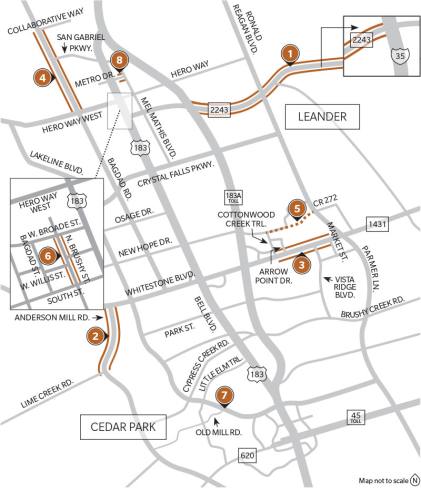Ongoing Projects
1. The Texas Department of Transportation’s feasibility study of RM 2243 between Toll 183A and I-35 is scheduled to be complete in the spring, Texas Department of Transportation spokesperson Diann Hodges said. The study is set to determine potential future roadway improvement projects and will cost TxDOT $710,719. Timeline: February 2015-spring 2018 2. The city of Cedar Park is realigning Anderson Mill Road as a four- and two-lane roadway from RM 1431 to Lime Creek Road. Construction is being completed in sections to permit continuous traffic, according to city documents. In February and March work on the project includes embankment work, base installation, paving and curb installation, according to city spokesperson Jennie Huerta. The city of Cedar Park and Williamson County are funding the $6.7 million project. Timeline: January 2017-late summer 2018 3. TxDOT is expanding RM 1431 from four to six lanes from Market Street to Cottonwood Creek Trail. In February and March the project’s contractor will work on retaining walls, bridge construction at Spanish Oak Creek, and roadway excavation and embankment, according to Hodges. The $12,847,145 is funded by TxDOT. Timeline: February 2017-late 2018/early 2019 4. The city of Leander is widening Bagdad Road from two to five lanes with a center turn lane between Hero Way West and Collaborative Way. In February and March installation of storm sewer and water lines will be completed, and construction on a new lane on the east side of the roadway will begin, city spokesperson Mike Neu said. The city of Leander and Williamson County are funding the project, which is expected to cost $8.5 million. Timeline: January 2018-late 20187. Intersection improvement Construction on a right-turn lane on Lakeline Boulevard onto Old Mill Road is now expected to be complete by the end of February, Huerta said. The city of Cedar Park finished turn lane construction on the intersections of Brushy Creek Road and Vista Ridge Boulevard, Brushy Creek Road and Lynnwood Trail and Discovery Boulevard and Whitestone Boulevard last year. Timeline: June-February Cost: no more than $514,340.50 Funding source: Community Development Corp. (4B Board)
8. Metro Drive extension Metro Drive will be extended to Mel Mathis Boulevard. The city of Leander is scheduled to advertise bids in March and start construction in April, Neu said. Timeline: construction begins late April Cost: $4.5 million Funding source: 2016 general obligation bonds
How it Works
When driving on the shoulder is legally allowed in Texas
Texas drivers are permitted to travel on an “improved shoulder,” or a paved shoulder, under certain conditions if determined necessary and if it can be completed safely, according to Section 545.058 of the Texas Transportation Code. Rule differ depending of the side of the roadway.
On the right shoulder driving is permitted in order to stop, stand or park the vehicle; to accelerate before entering the travel lane; or to slow down before making a right turn. Using the right shoulder is also allowed when passing another vehicle that is slowing or stopped in the travel lane or about to turn left, or to let a faster vehicle pass.
Drivers also have the option to use the right shoulder to avoid a collision or when required to by traffic-control devices, such as construction barrels.
On the left side, driving on the shoulder is permitted in order to slow or stop a disabled vehicle that cannot get to the right shoulder safely, to avoid a collision or when required to do so by traffic-control devices. But police and emergency vehicles and cyclists are not affected by those limitations, according to the law.
Despite these exceptions, Sgt. Stephen Woodard, spokesman for the Texas Department of Public Safety, said driving on the shoulder is not recommended. Emergency vehicles may need to use the extra lane, and other cars may pull into the shoulder before noticing another vehicle coming behind them.
“You just can’t make the improved shoulder your own personal lane … to get away from a slow driver,” he said.







